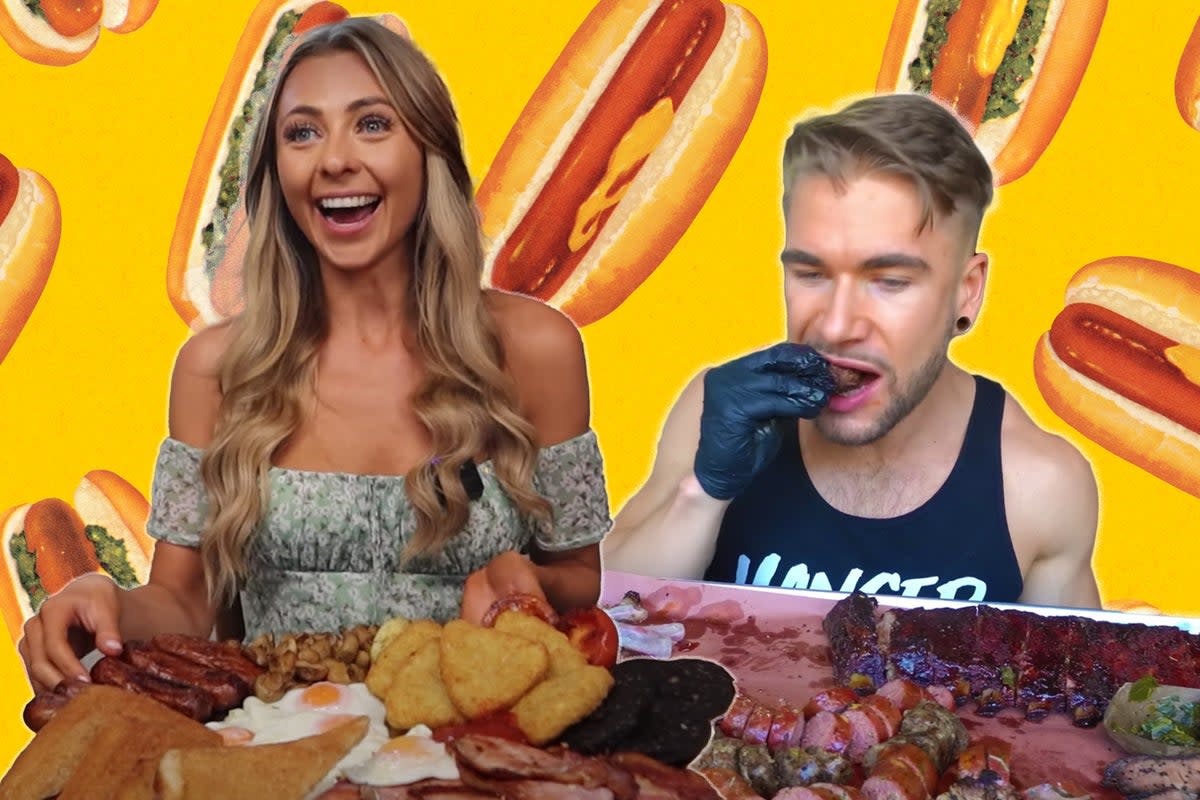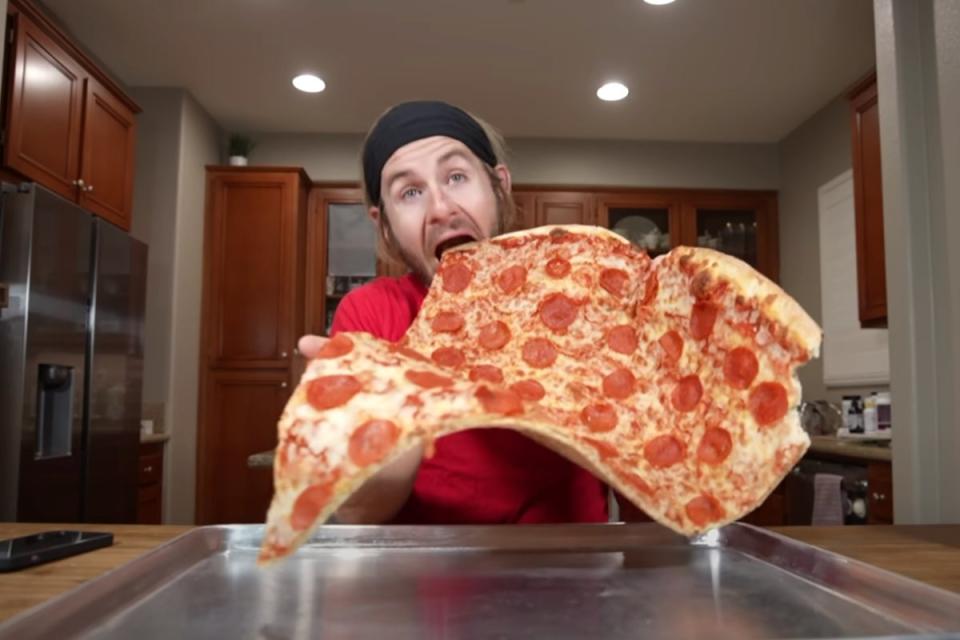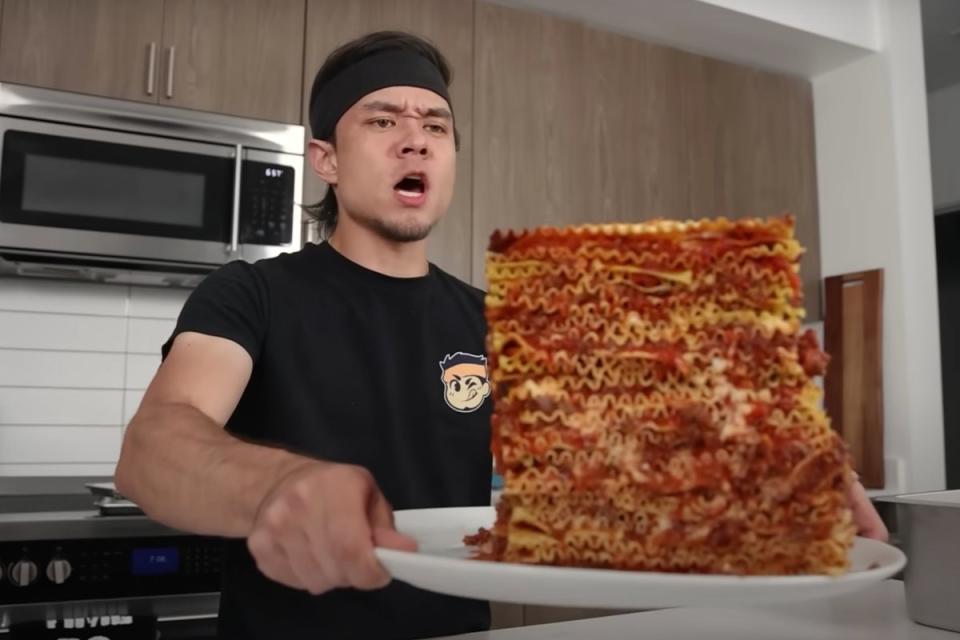Pizza, steak and 100 layers of lasagne: Inside the strange world of online competitive eating

- Oops!Something went wrong.Please try again later.
Tanned, blonde, muscular Californian Erik Lamkin is what you might imagine to be the platonic ideal of a YouTube fitness influencer. But the content that’s brought him legions of fans, a line of merchandise and 3.1 million subscribers on the platform doesn’t focus on the gym; it focuses on feats of gargantuan eating.
In one of Lamkin’s most popular videos, with more than 17 million views, the 30-year-old consumes 100,000 calories over the course of 100 hours. He is one of the biggest names in the world of online competitive eating, an uncanny valley of online sideshows where creators push themselves – and their stomach capacities – to obscene physical limits in the name of content.
And the content is lucrative. Alongside Lamkin there’s also Furious Pete, Joel Hansen (who goes by the handle Model vs Food) and the originator of overeating online content, Matt Stonie, whose most popular video sees him eat 14 packs of Korean fire noodles for an audience of 144 million viewers. Although this particular influencer industrial complex skews American – which makes sense, given that much of the US national identity is framed around fast food and consumption – there are competitive eating stars in the UK too; Leeds-based Adam Moran, aka BeardMeatsFood, has more than 3.4 million subscribers, and is matched by Kate Ovens, “the UK’s most unlikely competitive eater”. And as TikTok has emerged as a competitor to YouTube, many of these faces have moved there too; Jacked Eats, who describes his content as “aesthetics and lots of food”, walks 30,000 steps before heading to the office every day, and can consume 72 crumpets in a 24-hour period.
What unites them all is that despite what they eat they remain either remarkably thin or ripped to Adonis-like levels of fitness and aestheticism. These are content creators for the millennials and Zoomers who grew up watching US TV personality Adam Richman gorge himself to visible mental and physical illness on the reality show Man v. Food, but who care about dry-brushing and own a Peloton. Filming yourself consuming vast quantities of food isn’t new; even disregarding Richman, “mukbangs” have existed on YouTube for many years – they act as a kind of parasocial dinner companion, where we can watch someone silently eat while we eat watching them. These videos, though, are a new beast. In 25,000-calorie challenges and WIEIAD (What I Eat in a Day) TikToks, the creators gorge themselves and overspend on fast food before showing off their “after” physiques in which they look thin again. In the case of Lamkin’s videos, he includes before and after weights, and films his exercise breaks in between meals, where he is often close to the point of throwing up from exertion.
It’s been a year dominated by Ozempic discourse, the return of “indie sleaze” and the rise of a new, super-skinny body ideal that has replaced the BBL-obsessed, equally unattainable beauty standard that went before. It makes sense, then, for our appetite for overconsumption to only be indulged if we view it through the lens of wellness. This is why Richman is off the air, and influencers like Nikocado Avocado now frame their food videos through the lens of “weight loss journeys”.
But while these content creators pursue peak physical fitness, it’s worth asking what watching them does to our own mental health. Academic Mattias Strand and his researchers analysed 175,000 viewer comments on a number of popular mukbang videos on YouTube for their paper on mukbang content and how it intersects with “triggering” eating disorder content. While many comments were nonsensical and unhelpful – “gross!” or “that looks so good!” – the team did manage to find around 1,000 where commenters talked about their own relationship with food and eating in relation to the mukbang.
The results were ambivalent; some people viewed watching as a destructive habit, something they could use to either trigger their own binge eating episodes or help them to restrict their intake. Some were explicit; “I’m eating through you”, they wrote, “you’re eating for me so I don’t have to eat”. On the other hand, some viewers, perhaps those struggling with BED (Binge Eating Disorder) used mukbangs to avoid triggering their own binges.
It’s easy to understand how watching mukbang can inspire people to eat more, whether that’s good or bad. It’s a bit harder to understand why it inspires people to eat less
Mattias Strand
If researchers can find 1,000 of these comments, then surely the creators themselves can see them too. Following that logic, an interesting ethical dilemma emerges; what is a creator’s responsibility when they discover that they may be affecting the physical and mental health of pockets of their following?
“I think we all have some basic responsibility to try to not make others hurt, if we can,” says Strand. “And it’s probably wise for all influencers to try to show that they care about their audience.” But the framing of these food videos – as feats of endurance or simply an odd indulgence – means that it’s difficult to broach the subject. Influencers and YouTubers are, by definition, a cheerful type. “In the few cases we found where it was obvious that the mukbang creator wasn’t doing so well, I was struck by how most viewers were supportive and tried to say nice things to the person doing the mukbang, sometimes even things like ‘we love you for your personality, you don’t need to push yourself to eat more, just enjoy yourself, we will still like you’, things like that.”
It’s not just researchers who have found the odd link between online overconsumption and eating disorders; the creators, perhaps unsurprisingly, have sometimes suffered themselves. Lamkin, notably, has been open with his past struggle with anorexia and bulimia – which is especially grim when put alongside his current job, which is essentially bingeing content – and has spoken about being hospitalised for inpatient treatment. “That’s why I’m able to do what I’m able to do today, because I’m able to combat any negativity that I used to let get to me,” Lamkin, who originally began posting his food videos as a way to celebrate recovery weight gain, told Men’s Health. “I would say it definitely saved my life.”

It’s striking to see a YouTuber, particularly a fitness one and particularly a man, speak so candidly about their struggle with eating disorders, but there is a worrying overlap with the wellness-obsessed world we’ve now entered into, as well as the concept of being “recovered”. Learning to eat again and filming it has been both a positive and a lucrative experience for Lamkin. But it’s not a huge intellectual leap between the control required to overeat and then restrict the rest of the week to maintain a certain physique, and the mentality of extreme restriction that can lead down a path to anorexia.
Other YouTubers have been open about the fact that wellness and online food consumption, as well as the pressure to maintain a fitness influencer physique whilst still openly enjoying eating, was nothing more than a facade they had to abandon for the sake of their own mental and physical health. Three years ago, Stephanie Buttermore stopped enforcing her traditional fitness influencer physique to go on what she called an “all-in” weight-gain journey, eating whatever she wanted and letting go of the controlled lifestyle she’d pursued for online content. In the videos she subsequently posted chronicling the journey, she showed herself demolishing huge quantities of food in one sitting whilst at her thinnest, implying she was able to do so not because of superhuman feats of mental strength and stomach capacity, but simply because looking like a wellness influencer made her incredibly hungry, all the time.
Buttermore’s experience is revealing of what’s at the heart, I think, of our interest in watching these Herculean feats of eating. Whilst mukbangs might have been born out of societal loneliness, competitive eating is something we indulge because it triggers a curiosity within us; how can you eat like that and look like that?
“In general, the regular viewers seemed to mostly be fascinated by how the person doing the mukbang seems to remain healthy and athletic in spite of binge eating,” Strand tells me. “Many were suspicious and thought that there was something fishy about it, that perhaps they are engaging in purging behaviors after the video is done or that they are somehow editing the videos and so on. But it was rarely obvious that the hosts were in bad health or feeling bad. It’s probably much more difficult for audiences to identify those mukbang creators who are exercising and staying thin in unhealthy ways compared to identifying those who are obviously not able to ‘hide’ behind a wellness ideal – those who aren’t petite or athletic, basically.”

This is why much of the content around the nu-ideal of mukbangs is not “ew” or “wow” but “how”. This is why we see articles in which “mukbang stars” reveal how they “binge eat” but “stay healthy”. It’s why the YouTubers themselves will be interviewed talking about their diet and exercise regime, discussing how they can look the way they do while doing what they do. It’s framed as the anti-Ozempic; a lifestyle of suffering and sacrifice and mental resilience, of restriction as an art form and hard work as a lifestyle choice, rather than a fluke of genetics. But there’s an uneasy audience overlap that researchers like Strand have already uncovered that throws these kind of “how to” explanations into a more sinister light; if people watch your content to trigger their own eating disorders, should you really then fuel the fire by giving them more of a how-to guide to binge and restrict?
If it’s a link that competitive eating YouTubers are aware of, then it’s not one they want to talk about. I contacted a number of the industry’s biggest names and most-engaged platforms for this article, but not one of them agreed to speak to me about their work and their audiences. A number of pro-anorexia forums are full of links and recommendations for food overconsumption videos, which sufferers will use to dissuade themselves from overindulging in real life. In 2020, the writer Madeleine Cecilia even began a Medium blog where she lifted the lid on the practice, writing that overconsumption videos allowed her to fuel her own eating disorder. “I was hungry because I had anorexia,” it reads. “Usually, I stalked food accounts on Instagram to curb my hunger. It worked, but mukbangs worked even better. [They] would satisfy cravings that were impossible to fulfil unless I did the one thing that would put me into an anxiety spiral: eat.”
For many, admittedly, watching a mukbang or an eating challenge is like going to the zoo or putting reality TV on in the background while we’re cooking our own meals; it demands so little of us. We’re not really emotionally engaged at all. Others, though, view them differently. “Without going into detail about neural reward pathways, in an everyday sense it’s easy to understand how watching mukbang can inspire people to eat more, whether that’s good or bad,” Strand says. “It’s a bit harder to understand why it inspires people to eat less. Sure, some people simply comment that they lose their appetite because they think it’s gross, but it seems to me like it’s more to it than that. I would say that whereas watching someone eat one bowl of ramen noodles might make you hungry, watching someone eating 15 bowls of ramen can be more unsettling or almost uncanny.”
For most viewers, it’s probably this sense of the uncanny that draws us in. The majority of those who watch out of a sense of morbid curiosity themselves have no particular problems with eating. For millions of people it’s merely a means to get to know the creator behind the consumption. But for others, those more deeply enmeshed in the URL and/or IRL worlds of wellness culture or eating disorders, there’s a sinister attraction: watching a physically attractive person eat so you don’t have to. And as we head into a new year with all the usual signposts to punish ourselves with diet and exercise after festive indulgences, coupled with an increased interest in post-Ozempic thinness, it makes sense that this genre of video isn’t going away. It’s why “What I Eat in a Day” calorie challenges haven’t abated as YouTube has given way to Instagram Reels and TikToks; the content hasn’t changed, the platform has. And we still can’t stop watching.

